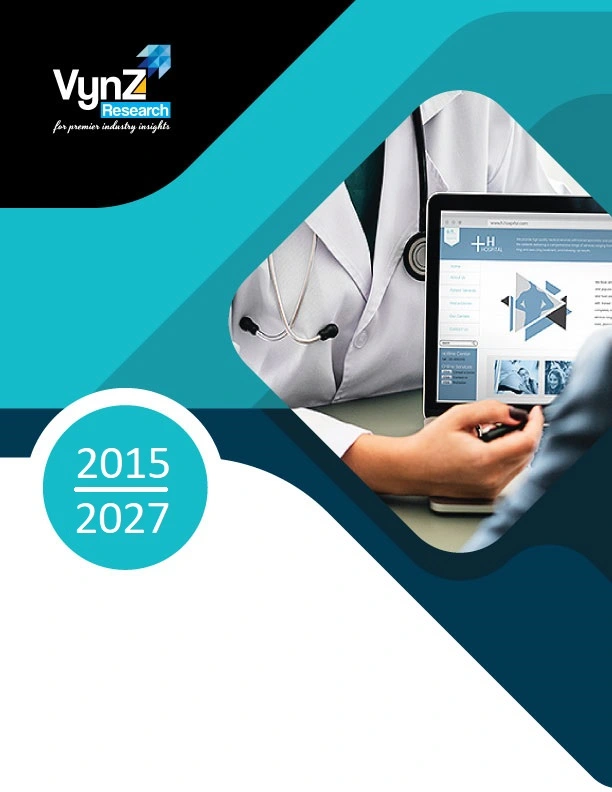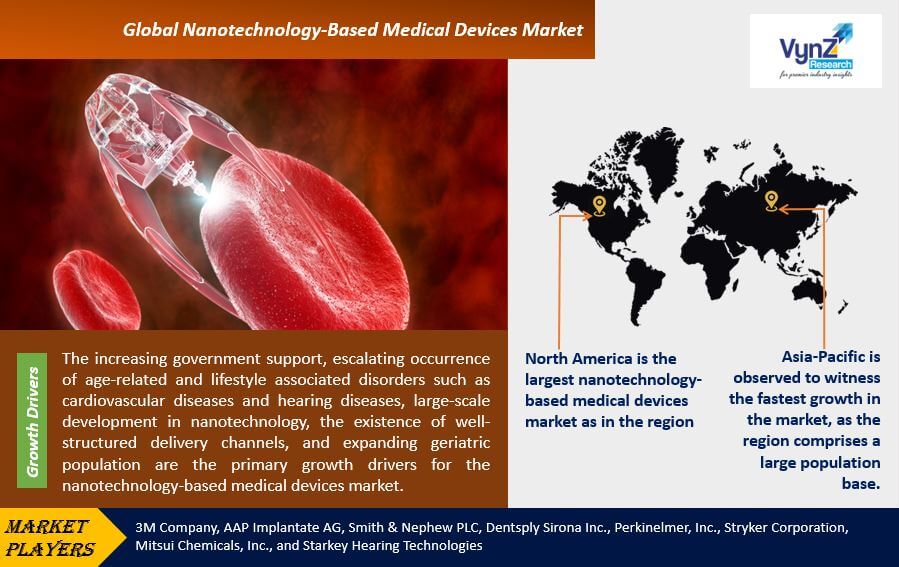| Status : Published | Published On : Dec, 2023 | Report Code : VRHC1079 | Industry : Healthcare | Available Format :

|
Page : 200 |

Global Nanotechnology-Based Medical Devices Market – Analysis and Forecast (2025-2030)
Industry Insights by Product (Active Implantable Devices, Medical Textiles, and Wound Dressings, Biochips, Implantable Materials, and Others), and by Application (Therapeutic Applications, Research Applications, and Diagnostic Applications)
Industry Overview
The Nanotechnology-Based Medical Devices Market was valued at USD 1.90 billion in 2023 and is anticipated to reach USD 20.15 billion in 2030, registering a CAGR of 36.3% during the forecast period 2025-2030. The nanotechnology-based medical device helps in medical diagnosis, prevention of disease, and treatment. Nanotechnology in medicine devices includes the use of nano-robots to create repairs at the cellular level and treat and detect damage to the human body. The global nanotechnology-based medical devices market is growing at a significant rate, due to expanding geriatric population and increasing government initiatives. The nanotechnology-based medical devices market refers to the application of nanotechnology in the development of medical devices. Nanotechnology involves manipulating and controlling matter at the nanoscale level, which is approximately 1 to 100 nanometers in size. This technology has the potential to revolutionize the healthcare industry by enabling the creation of smaller, more precise, and efficient medical devices.The market for nanotechnology-based medical devices has been growing steadily in recent years. These devices offer several advantages over traditional medical devices, including improved sensitivity, enhanced drug delivery systems, and the ability to target specific cells or tissues.

Different products such as biochips, active implantable devices, and medical textile and wound dressings contributed to the nanotechnology-based medical devices market size. The market has witnessed high demand for active implantable devices over the last few years due to mounting out-of-pocket healthcare expenditure, escalating occurrence of age-related and lifestyle-associated disorders such as cardiovascular diseases and hearing diseases, and accessibility of insurance coverage and reimbursement for medical procedures.
Nanotechnology-Based Medical Devices Market Segmentation
Insight by Product
On the basis of product, the market is subdivided into active implantable devices, medical textiles, and wound dressings, biochips, implantable materials, and others. Of all product, active implantable devices segment anticipated the largest share in the market due to the increasing out-of-pocket healthcare expenditure, the existence of well-structured delivery channels, escalating occurrence of age-related and lifestyle associated disorders such as cardiovascular diseases, and accessibility of insurance coverage and reimbursement for medical procedures.
The implantable material segment is further subdivided into bone substitute materials and dental restorative materials. Moreover, the biochip segment is further subdivided into Lab-On-Chip, and DNA microarrays. In addition, the active implantable devices segment is further subdivided into hearing aid devices, retinal implants, and cardiac rhythm management devices.
Insight by Application
On the basis of application, the market is subdivided into therapeutic applications, research applications, and diagnostic applications.
Global Nanotechnology-Based Medical Devices Market Report Coverage
|
Report Metric |
Details |
|
Historical Period |
2018 - 2023 |
|
Base Year Considered |
2024 |
|
Forecast Period |
2025 - 2030 |
|
Market Size in 2024 |
U.S.D. 1.90 Billion |
|
Revenue Forecast in 2030 |
U.S.D. 20.15 Billion |
|
Growth Rate |
36.3% |
|
Segments Covered in the Report |
By Product and By Application |
|
Report Scope |
Market Trends, Drivers, and Restraints; Revenue Estimation and Forecast; Segmentation Analysis; Impact of COVID-19; Companies’ Strategic Developments; Market Share Analysis of Key Players; Company Profiling |
|
Regions Covered in the Report |
North America, Europe, Asia-Pacific, Middle East, and Rest of the World |
Industry Dynamics
Nanotechnology-Based Medical Devices Market Growth Drivers
The increasing government support, escalating occurrence of age-related and lifestyle associated disorders such as cardiovascular diseases and hearing diseases, large-scale development in nanotechnology, the existence of well-structured delivery channels, and expanding geriatric population are the primary growth drivers for the nanotechnology-based medical devices market. For instance, according to the World Health Organization (WHO), globally in 2010 approximately 524 million people were aged 65 years and older and is expected to reach 1.5 billion in 2050.
Abundant mid-to-late stage product pipeline, escalating awareness about preventive measures in healthcare, accessibility of insurance coverage and reimbursement for medical procedures, mounting healthcare expenditure, advancement in technology, and huge growth opportunities in emerging markets are also facilitating the growth for the nanotechnology-based medical devices market.
Miniaturization: Nanotechnology allows for the miniaturization of medical devices, making them smaller, lighter, and more portable. This has significant implications for point-of-care diagnostics, wearable devices, and implantable devices that can be more easily integrated into everyday life.
Diagnostic Advancements: Nanotechnology has enabled the development of highly sensitive and specific diagnostic tools. Nanosensors and nanomaterials can detect biomarkers at low concentrations, aiding in early disease diagnosis and monitoring.
Imaging Enhancements: Nanotechnology has improved medical imaging techniques by developing contrast agents and nanoparticles that enhance imaging resolution and specificity. This has led to advancements in techniques such as magnetic resonance imaging (MRI), computed tomography (CT), and molecular imaging.
Increasing Prevalence of Chronic Diseases: The rising prevalence of chronic diseases, such as cancer, cardiovascular disorders, and diabetes, has created a demand for advanced medical devices that can provide better treatment outcomes. Nanotechnology-based medical devices offer promising solutions for the diagnosis, treatment, and monitoring of these diseases.
Nanotechnology-Based Medical Devices Market Challenges
Strict and time-consuming product approval processes, insufficient standards and absence of regulatory approval frameworks, and elevated cost of medical devices are the major challenges for the growth of nanotechnology-based medical devices market.
Nanotechnology-Based Medical Devices Market Industry Ecosystem
Globally, the manufacturing companies trying to enter the nanotechnology-based medical devices market are required to maintain stringent regulatory standards. Moreover, the high level of capital requirement also poses a major barrier to the entry of new players. This offers an edge to the established players in the industry competition.
Enhanced Performance: Nanotechnology enables the development of medical devices with improved performance and functionality. Nanoscale materials can exhibit unique physical, chemical, and biological properties, allowing for more precise and efficient diagnostics, drug delivery systems, and implantable devices.
Targeted Delivery: Nanotechnology enables targeted drug delivery systems, where therapeutic agents can be precisely delivered to the affected cells or tissues, reducing side effects and improving treatment efficacy. Nanoparticles and nanocarriers can be designed to release drugs at specific sites, improving the therapeutic outcomes.
Favorable Regulatory Environment: Regulatory agencies, such as the U.S. Food and Drug Administration (FDA), have recognized the potential of nanotechnology in healthcare and have streamlined the regulatory pathways for nanotechnology-based medical devices. This has encouraged research and development in the field and facilitated market growth.
Nanotechnology-Based Medical Devices Market Geographic Overview
Geographically, North America is the largest nanotechnology-based medical devices market as in the region the geriatric population is increasing. For instance, according to the U.S. Census Bureau, in 2012 approximately 43.1 million people were aged 65 years and older in the U.S. and is expected to reach 83.7 million in 2050. Escalating healthcare expenditure, numerous nanotechnology development programs introduced by the government, extremely developed healthcare system, mounting occurrence of chronic diseases such as cardiovascular diseases, and the existence of an enormous number of nanotechnology-based medical device manufacturing companies are also up surging growth of the North American nanotechnology-based medical devices market. For instance, according to according to Centers of Disease Control and Prevention (CDC), in the U.S. approximately 610,000 people die every year due to heart disease.
Asia-Pacific is observed to witness the fastest growth in the market, as the region comprises a large population base. In addition, expanding the geriatric population, escalating healthcare expenditure, mounting R&D expenditure in nanotechnology, the mounting occurrence of chronic and lifestyle associated disorders such as cardiovascular diseases, refining healthcare infrastructure, and escalating international research collaboration is also creating a positive impact on the nanotechnology-based medical devices market growth in the region.
Nanotechnology-Based Medical Devices Market Competitive Insight
Key players in the nanotechnology-based medical devices market are catering to the demand of these devices by investing in technologically advanced products in their product portfolio across the globe.
AAP Implantate AG is a globally active medical technology company based in Berlin, Germany. Company manufacture, develop and market products for trauma. Company have an innovation pipeline with promising development projects such as our antibacterial silver coating technology and magnesium-based implants. These technologies address critical and unmet needs in trauma. Products are sold in Germany directly to hospitals, purchasing groups and hospital groups at international level company primarily use a broad network of distributors in around 25 countries.
Smith+Nephew is a portfolio medical technology company that focused on the repair, regeneration and replacement of soft and hard tissue.
3M Company, AAP Implantate AG, Smith & Nephew PLC, Dentsply Sirona Inc., Perkinelmer, Inc., Stryker Corporation, Mitsui Chemicals, Inc., and Starkey Hearing Technologies are the key players offering nanotechnology-based medical devices.
Recent Developments by Key Players
Smith+Nephew, the global medical technology company has launched its RENASYS EDGE Negative Pressure Wound Therapy (NPWT) System in the US as a patient-centric option for treating chronic wounds. The system is compact and lightweight that allowed it to be easily carried or worn. It operates quietly so the patient is not disturbed.
Dentsply Sirona once again joins its long-time partner FDI World Dental Federation to promote World Oral Health Day (WOHD) and contribute to raising global awareness for the importance of good oral health.
The Nanotechnology-Based Medical Devices Market report offers a comprehensive market segmentation analysis along with an estimation for the forecast period 2025–2030.
Segments Covered in the Report
- By Product
- Active Implantable Devices
- Medical Textiles, and Wound Dressings
- Biochips
- Implantable Materials
- Others
- By Application
- Therapeutic Applications
- Research Applications
- Diagnostic Applications
Region Covered in the Report
- North America
- U.S.
- Canada
- Mexico
- Europe
- Germany
- U.K.
- France
- Italy
- Spain
- Russia
- Rest of Europe
- Asia-Pacific (APAC)
- China
- Japan
- India
- South Korea
- Rest of Asia-Pacific
- Rest of the World (RoW)
- Brazil
- Saudi Arabia
- South Africa
- U.A.E.
- Other Countries
.png)
Source: VynZ Research
Frequently Asked Questions
Purchase Options
Latest Report
Research Methodology
- Desk Research / Pilot Interviews
- Build Market Size Model
- Research and Analysis
- Final Deliverabvle
Connect With Our Sales Team
- Toll-Free: 1 888 253 3960
- Phone: +91 9960 288 381
- Email: enquiry@vynzresearch.com
Nanotechnology-Based Medical Devices Market
